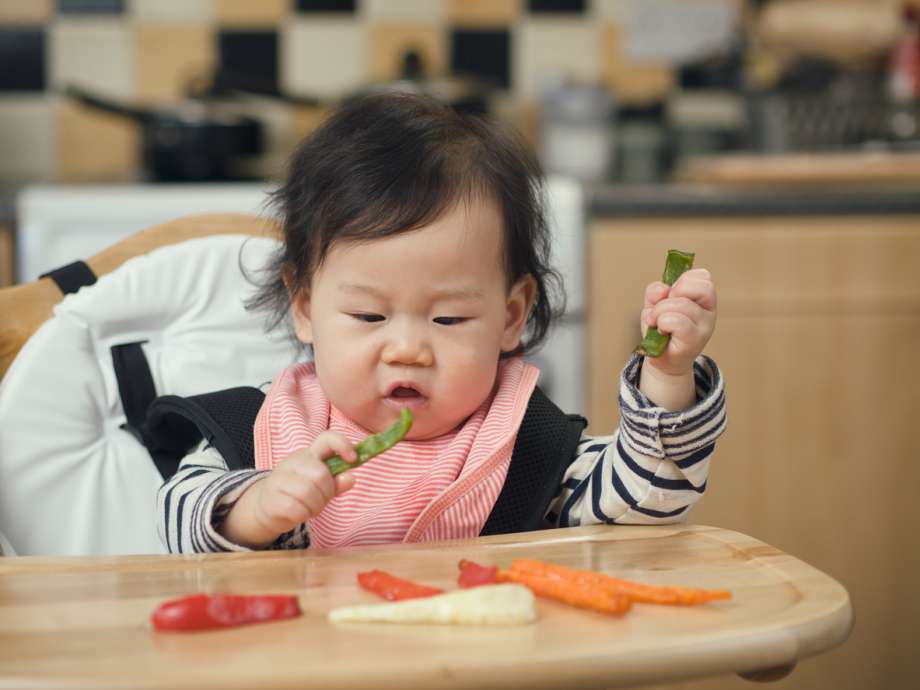The Best Foods for Baby-Led Weaning

There are many choices when it comes to how to feed our little ones. Often, moms are so consumed by feeding in the first few months of a baby’s life - whether it be through breastfeeding, coordinating bottles, pumping, or a hybrid of any and all options - that the introduction to solid foods can sneak up on us. An approach to the introduction of solid food called baby-ledweaningis a wonderful option to consider, but it’s one that takes a bit of time and research to get fully acquainted with.
More:How to Tell If Your Baby Likes a New Food
What exactly is baby-led weaning?
Baby-led weaning is an approach tointroducing your baby to solid food. Ideally, your little one, who is at least six months of age, joins the rest of the family at meal times. You offer her regular food that is shaped in a way that is easily handleable by her little hands. The baby then feeds herself what she would like from this selection. The idea is that babies learn about food naturally, learn to eat safely, and simultaneously gain confidence as eaters.
How do I know my baby is ready to try baby-led weaning?
The baby should be at least six months of age and display certain specific signs of readiness. Signs of readiness for solid foods include:
- sitting up well without support
- losing the tongue thrust reflex where the baby’s tongue pushes the food out of the mouth instead of helping it go in.
Other signs of readiness are:
- reaching for food on her own
- showing signs of interest when people around her are eating
- developing a pincer grasp where the baby can use her thumb and forefinger to pick things up.
Where can I find additional information about baby-led weaning?
We recommend the bookBaby-Led Weaning: The Essential Guide to Introducing Solid Foods and Helping Your Baby Grow Up a Happy and Confident Eater(if you decide to purchase, we may earn a small commission for it). This is an extremely helpful guide to understanding why babies do not need to be spoon fed and how to safely take your baby through the eating adventure of baby-led weaning.
Another helpful baby-led weaning resource is the websitehttp://www.babyledweaning.com/.
What foods should I start with for baby-led weaning?
Your baby can try eating almost anything that your family is eating, but here are 20 foods that we recommend for ease as you get started with baby-led weaning.
- Steamed carrots
- Sticks of cucumber
- Avocado slices
- Toast sticks
- Crinkle cut bits of mango
- Multigrain rice cakes
- Hummus - Babies love to dip many of these foods!
- Banana
- Roasted sweet potato wedges
- Roasted apple wedges
- Steamed green beans
- Soft-cooked broccoli
- Soft-cooked cauliflower
- Very ripe pear slices
- Egg omelet strips
- Hard-boiled egg slices
- Steamed zucchini spears
- Peas
- Pepper slices
- Sliced cheese
Tips for getting started with baby-led weaning
- Baby-led weaning is great forteething! Giving your baby a nice, cold food that she can easily gnaw on and handle. It kills two birds with one stone.
- Cut food (toast, fruit, etc.) into stick or spear shapes that are about the size of your tallest finger. This makes the food easy to handle and also helps your baby work on her grip and coordination.
- If you havepureed baby foodleft over from first trying traditional baby feeding, if you have various kinds of dips in your refrigerator (hummus, yogurt, etc.), or if you just want to introduce the baby to a new flavor or taste easily, offer it as a dip. You can put the dip right on to the table or high chair tray. If foods are in the stick or spear shape, your baby will enjoy dipping. You can also spread these on stick shaped toast.
- Don’t worry if your little one is not ingesting much food in the beginning. It’s a learning process and breastmilk or formula should still be the primary food at this point. Your baby is learning about the process of eating naturally and working hard at developing the physical skills necessary to eat. This is all good for your baby and helpful in the long run.
- Some foods may be too slippery for your baby to hold on to at first. You can always make a coating to help though! For instance, a slippery banana can be coated with crushed Cheerios. You’ll find it stays in your baby’s grip much more easily this way.
- Prepare for a mess. Having a splatter mat set up underneath where your baby is eating will make clean up much easier. Remember, flying food means your baby is naturally beginning to enjoy the eating process!
- Anything you can do to help create texture on various foods will help your baby hold on to it. For instance, crinkle cutting fruits and veggies make them much easier to handle.
- Even if you’re focused on beginner foods like the ones on our list, don’t hesitate to put a little of whatever the family is eating for dinner on her tray. This will help her develop different tastes, sit with the family during meal times with interest, and learn to handle different foods.
- An easy to clean high chair goes a long way. The more tiny crevices and materials that are part of the high chair, the more there will be for you to clean.
- Lastly, try not to be nervous. Allow your little one the time and space she needs to figure out how to feed herself. Never leave your baby unattended while eating, but you don’t need to put the food in her mouth either.

